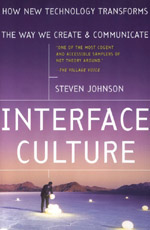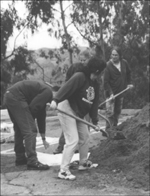 (Reproduced with permission from the Atlantic Monthly’s Web-only magazine Atlantic Unbound, written by Harvey Blume.)
(Reproduced with permission from the Atlantic Monthly’s Web-only magazine Atlantic Unbound, written by Harvey Blume.)
Most of us take the computer interface for granted. But for Steven Johnson it is a defining metaphor of our times—and a summons to the metaphysical.
As he conceives it, the unnerving gap between “raw information and its numinous life on the screen” is the setting for the interface, the evolving medium through which computer users control their machines. In Interface Culture, Johnson, a founding editor of the influential Webzine FEED, expands on the practical and metaphorical ramifications of the computer interface as no one has ever thought to do. For Johnson, the interface is not just a convenience—a way to copy files, launch programs, or nudge a machine through the eye of a modem out into cyberspace. It is an art form, a window on culture, history, and technology. If you are Steven Johnson, the interface is the source of a recurrent invitation to fear and trembling, your muezzin summoning you to prayer.
The question, obviously, is whether a computer interface can live up to such exalted claims. If you can see heaven in a grain of sand, does that mean you will necessarily also find it in the Graphic User Interface? Programmers know the GUI as an illusion, the product of operating-system routines meshing so smoothly that the user is never exposed to the sight of icons, menus, windows, and the rest dissolving into the aimless binary digits out of which they are composed. Even so, some programmers are provoked to wonder if the universe isn’t built along similar lines, propagating itself at a high-enough refresh rate so that humans don’t detect the Supreme Hacker behind trillions of lines of (mostly) bug-free Cosmic Code.
The computer interface may never rate—as Johnson suggests it will—with “the novel or the cathedral” as a means of joining heaven, earth, and society. But whether or not the GUI and its descendants are, in fact, evolving toward a significance that will belie their digital origins, Interface Culture remains a rewarding read—stimulating, iconoclastic, and strikingly original.
Johnson’s first chapters hinge on speed, a defining element of both microprocessors and contemporary culture. Johnson stresses that the very speed with which media mutate in our day calls attention to them: “We can grasp the way different media shape our habits of thought because we can see the progression, the change from one form to another.” Rate of change brings media out of the shadows. It propels Gutenberg toward the likes of Marshall McLuhan and, by extension, language toward the likes of Noam Chomsky.
For Johnson, the computer interface affords a privileged outlook on prior media. Basing his thinking on the fact that art and technology are inseparable in interface design, Johnson asserts that they were never truly distinct in the first place. “When James Joyce published Ulysses in 1922 and revolutionized all of our expectations about how books should work, was he so different from Gutenberg himself?” His answer: “Joyce was a highly skilled technician, tinkering around with a book-machine, making it do things it had never done before.”
The tendency in discussions of art and technology is to assume basic difference and to crawl cautiously toward common ground, all the while ducking heavy fire from both sides. It is refreshing to encounter someone who starts with the assumption that art and technology are similar, even identical, and writes off difference as nothing but artifact, distortion that set in and assumed the appearance of solidity during periods of slow change. Johnson concludes his comparison of Joyce with Gutenberg by stressing, “They were both artists. They were both engineers. Only the four hundred years that separated them kept their shared condition from view.”


























